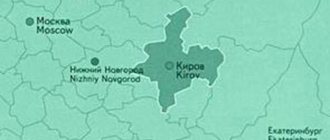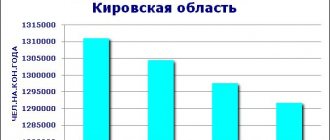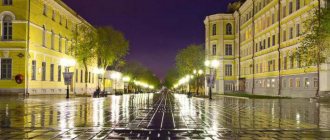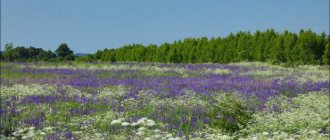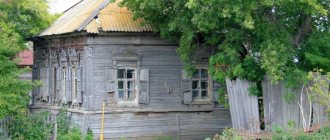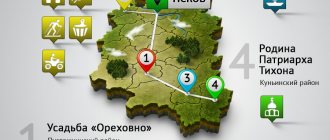General information about the Kirov region
Distinctive features .
Periphery. Such a short but succinct word can characterize the historical essence of the land of Vyatka, now called the Kirov region. The first cities in these lands were founded by settlers from Veliky Novgorod, and after the invasion of the Mongol-Tatars, the local population quickly began to swell with refugees from the southeast. By the will of fate, Vyatka found itself at the crossroads of interests of the strongest states of northeastern Europe - the Novgorod Republic, Volga Bulgaria, and the Vladimir-Suzdal Principality. The Vyatchans had to fight a lot with their neighbors, and they entered into alliances either with Suzdal or with Moscow. And as a result, in the 15th century, Vyatka became part of the Moscow state.
Assumption Trifonov Monastery in Kirov. Photo by Vladimir Ogleznev (https://fotki.yandex.ru/users/trans338/)
Vyatka represents a classic example of a Russian province. They say that Saltykov-Shchedrin, when writing his famous satirical work “The History of a City,” used Vyatka as a prototype. Moreover, analyzing the unforgettable masterpiece of Ilf and Petrov “12 chairs”, some argue that in the homeland of Kisa Vorobyaninov - “county town N” - features of Vyatka can also be traced. And Kisa’s rich ancestor painfully resembles the merchant of the first guild Stakheev, a native of the Vyatka lands.
However, if we ignore the literature and return to reality, today the Kirov region is an industrially developed region, where mechanical engineering and metalworking, chemical and forestry industries play a major role. But the region lives not only with modern production. Folk crafts that delight the Russian soul are also loved and remembered here.
The famous Dymkovo toy - painted clay whistles - is a local pride. Another pride is Vyatka lace, with its unique weaving technology. In general, the historical memory of local residents is such that many will envy. Maybe this is why the local native, the great Russian artist V.M. Vasnetsov, loved to turn to the theme of Russian folklore in his paintings? It is possible that Russian culture in the Vyatka region is absorbed along with mother’s milk.
Geographical location . The Kirov region is part of the Volga Federal District. Neighboring it are: in the east - the Perm Territory and Udmurtia, in the north - the Komi Republic, the Arkhangelsk region, in the south - the Mari El Republic and Tatarstan, in the west - the Kostroma, Nizhny Novgorod and Vologda regions.
The terrain is predominantly hilly. There are several large hills (one of them is Vyatskie Uvaly), almost 20 thousand rivers. But the main river is the Vyatka, which flows into the Kama. The main natural zones in the region are coniferous and mixed forests. There is a large nature reserve - Nurgush, as well as several reserves.
Population. As of 2013, the population of the region was 1,319,076 people. Of these, 72% live in cities. Population density - 10.96 people. per sq. m. The main nationalities are Russians (89.44%), Tatars (2.72%), Mari (2.12%), Udmurts (1%). The ratio of male to female population is 45.9%: 54.1%. The region is characterized by a slight excess of mortality over the birth rate (2.8 people per 1000 population). Since there are very few people who want to move here, rather the opposite, the population of the region is gradually melting away.
Participants in the opening ceremony of the Universiade in Kirov
Crime . The Kirov region is not a criminal region. In the federal ranking it ranks 49th in terms of the number of crimes committed. In general, everything here is quiet and calm.
The unemployment rate in the Kirov region is 7.10%. Unfortunately, business activity in the region is not very high, and there are not enough large machine-building enterprises to provide everyone with work. On the other hand, the money offered for work is not so great that there would be a lot of people willing to work for it. The average salary in 2012 was only 16,783 rubles.
Property value. Housing prices in Kirov are relatively low. The average cost per square meter in the city is 46,122 rubles. A one-room apartment in the center can be bought here for 1.3 million rubles. For a good two-room apartment you will have to spend much more - 2.5 million rubles and more.
Climate. The Kirov region is located in northern latitudes, and therefore there are frequent severe frosts in winter and sharp cold snaps in summer. The climate type is temperate continental. The average temperature of the coldest month of January is −15°C. The average temperature in July is +18°C. Precipitation is quite frequent here. The average annual precipitation is 680 mm Hg. Art.
Geography
Natural resources
The basis of natural resources is forests (mainly coniferous), phosphate stone, peat, furs, water and land resources. Deposits of peat and non-metallic minerals are widespread: limestone, marl, clay, sand and gravel, as well as the extremely rare mineral volkonskoite. In recent decades, insignificant recoverable oil reserves and bentonite clay deposits have been discovered in the east of the site. The region is home to Europe's largest Vyatsko-Kama phosphorite deposit. The area is rich in mineral springs and healing mud. On the territory of the Kumionsky district is the famous resort town of federal significance Nizhneevkino, where residents of the Kirov region and many regions of Russia come for treatment and recreation.
Hydrography
The total length of the region is 19753 rivers - 66.65 km. Northern Uvals are two separate river basins - Severodvinsk and Volga. Most of the area is occupied by the Vyatka River basin, a tributary of the Kama to Tatarstan. On the Kama there are only in the upper reaches. The large currents within the area also include river mole and tansy, Luza, Kobra, Cheptsa.
The total number of lakes in the area is 4.5 thousand ponds, with a total number of closed water areas of 5.5 million. The largest lakes: Akshuben - 85 hectares, Orlovskoye - 63 hectares, Muserskoye - 32 hectares. The deepest area of the Lezhninskoye Lake pond is 36.6 m.
Cities of the Kirov region
Kirov, or Vyatka, as it was called in the old days, is the regional center and the largest city in the region. Population - 473,688 thousand people. Since 1970 it has been a historical city of Russia. This means that there are many historical and architectural monuments located here that are of great value for the Russian Federation.
This is a large regional industrial center. But, unfortunately, there is not much reason for joy here. Terrible roads, low wages, environmental problems, dilapidated housing stock that requires major repairs. The advantages include a relatively favorable crime situation and beautiful nature in the surrounding area.
Kirovo-Chepetsk is the second largest city in the region, population - 77,166 people. It is located just 22 km from Kirov and is part of the Kirov agglomeration. It was founded in 1935 due to the Kirovo-Chepetsk thermal power plant being built here. At first it was a small workers’ village, and it became a city only 20 years later.
In addition to the power plant, there are several large enterprises here: a mineral fertilizer plant, a mechanical repair plant and a number of other production facilities. Kirovo-Chepetsk has the same problems as Kirov, only raised to the second degree. If you find yourself on one of its streets, you get the impression that you got into a time machine and found yourself in the era of Gorbachev’s perestroika.
Slobodskoy is the third largest city in the region, with a population of 36 thousand people. Part of the Kirov agglomeration. Despite its small size, this ancient city was known at the end of the 15th century. Slobodskaya is also the birthplace of the writer Alexander Green, who gave us Scarlet Sails. The city has a long trading tradition, and today there is a developed food industry, as well as the production of matches and fur products.
Policy
During the Soviet period, high authority in the region was divided between three persons: the first secretary of the Kirov Committee of the CPSU (who actually had the greatest powers), the chairman of the regional Council (legislative branch) and the chairman of the regional executive branch. Committee (executive branch). Since 1991, the CPSU lost all power and the head of the regional administration, and as a result the governor was appointed/elected along with the elected ones. regional parliament.
The Charter of the Kirov Region is the basic law of the region. The Legislative Assembly of the Kirov Region is a permanent legislative (representative) body of the region. The Legislative Assembly exercises its powers by adopting laws, regulations and other legal acts, as well as monitoring the implementation and compliance with the laws and other legal acts adopted by it. The highest executive body is the Regional Government, which includes territorial executive bodies such as district administrations, committees and commissions that promote development and manage the day-to-day affairs of the region. The regional administration supports the activities of the Governor, who is the highest official and acts as a guarantor of compliance with the regional charter in accordance with the Constitution of Russia.
Regional districts
The administrative territorial division of the region includes 39 municipal districts. Let's consider some of them by the number of people living in their territories:
- Arbazhsky district is located in the southwest of the Kirov region. The urban-type settlement of Arbazh is its administrative center. The district is home to 6,056 residents.
- Bogorodsky district with a population of 4172 people is modestly located in the eastern part of the central part of the region. The administratively significant place is the urban-type settlement (hereinafter referred to as the urban-type settlement) Bogorodskoye.
- In the southeast of the region, the Malmyzh district has existed since 1929, in which the city of Malmyzh is the main regional entity. The population is 23,533 people.
- Nemsky district, with the administrative center - the town of Nema. Numbers 6928 villagers.
- 29,680 people live in the Orichevsky district. The village of Orichi is the administrative center.
- The Sovetsky district united 25,146 residents on its territory. The main regional subject is the city of Sovetsk.
- Lebyazhsky district has a population of 7,371 people. The administrative center is the urban-type settlement Lebyazhye.
- There are 9,773 inhabitants in the Pizhansky district.
- Falensky has a population of 9,247 people.
- Yaransky district united 23,753 residents.
Crime in Vyatka style
Kirov is such a quiet province that even in the famous 90s nothing terrible happened here. No one was rolled into concrete or guarded. Local businessmen quietly divided their zones of influence, traded, shuttled, opened new stores and built residential buildings.
Vyatka is not a serious criminal area; all crimes, both then and now, happen here due to stupidity and drunkenness. The 43rd is a poor region, even officials, let alone large mafia structures, are not interested in stealing there!
Local features
A variety of competitions and festivals are held on the territory of the Kirov region, among them: the All-Russian dance festival for the prize of the People's Artist of the Russian Federation V.M. Zakharov, the All-Russian competition of masters of artistic expression “My Russia” , the interregional festival of national cultures “Firebird” , the International music festival “Vyatka Spring” , open festival of social film and television programs “Vyatka” , All-Russian festival of modern man-made toys, All-Russian Vasnetsov plein air .
What to bring from the Kirov region
The Kirov region is famous in Russia for the production of footwear and fur products.
Folk crafts are widely developed here: wood painting, linen products with traditional embroidery, Kukar lace making, Dymkovo clay painted toys, products made from burl root, straw, pine root, wood, wicker, and ceramics.
We have collected five facts about what our region is famous for
The history of the Vyatka region goes back many centuries, as evidenced by the large number of ancient mounds and ancient settlements. Interesting facts about Vyatka are still being discovered. Thanks to an article in our newspaper, the legal successor of the treasure , which was found in the Yaransky district, was found. The documents were in a sweet chest from the once famous confectionery factory of the merchant Yakubovsky in Vyatka.
We decided to find out what unique crafts, traditions and materials our region is famous for.
Vyatka kikimora.
Since ancient times, Kikimora has been considered a character from the Vyatka hinterland. The basis for recognizing the city as the birthplace of this fairy-tale character was the existence of Kikimorskaya Mountain in the city, as well as Kikimorskaya Street, which is now called Vodoprovodnaya.
And the story of the appearance of kikimora on Vyatka is this: Novgorodians left logs on the mountain to build a city, fell asleep, and in the morning the logs were already in another place. So they thought that it was unclean and that kikimoras lived there,” said Anton Kasanov, a historian.
Now in Zarechny Park behind Vyatka there is the residence of Kikimora Vyatskaya. This fairy-tale character lives there.
Procession.
The Velikoretsky Procession of the Cross was and remains the longest procession of the cross in the Orthodox world and one of the most crowded in Russia.
It takes place from June 3 to June 8. Every year, more than 20 thousand pilgrims from all over Russia and other countries equip themselves with tents, sleeping bags, repellents for ticks and mosquitoes and go with the revered icon of St. Nicholas the Wonderworker to the village of Velikoretskoye. On the day of the holiday itself, about 40 thousand pilgrims gather on the Velikaya River. The total route in both directions is 150 kilometers, explained the press service of the Vyatka Diocese.
Every year the procession is accompanied by rain at the beginning and end of the long journey, and when the believers return to the city, real summer begins.
Volkonskoit.
Volkonskoite is a rare clay mineral with a high chromium content. It was opened in 1830 in the Perm province. In the Kirov region, deposits are located in the Uninsky and Bogorodsky districts.
Green paint was made from “green clay”. It is distinguished by transparency, chemical resistance, and high light fastness. During the Great Patriotic War, tanks were painted with her,” said Tamara Vitalievna Romanchuk, director of the Geological Museum of Natural History.
Currently there is no mining of the mineral; its reserves are very small. The Volkonskoite deposit is a geological natural monument.
Wooden temple sculpture.
Sculptures are not very common in the Orthodox Church. The most famous are the wooden sculptures of the Perm region. But they are also found in our region. For example, the Sloboda Local History Museum houses 19 wooden sculptures - this is the only collection in the region. All of them were created in the late 18th and early 19th centuries.
When the temples were being destroyed, someone took out the sculptures. Until the 80s, they were kept in the attic of the former Annunciation Church of Slobodsky, where the local history museum is now located,” said Sergei Mikhailovich Bushmakin, head of the museum’s methodological center. – When they began to prepare the exhibition in the wooden Church of the Archangel Michael, they took out the sculptures from the attic. It was possible to establish the place where some of them were brought from. Four are from the church in the village of Pantyl (Belokholunitsky district) and four are from the Annunciation Church in the village of Shestakovo (Slobodsky district). The origin of the remaining sculptures is unknown.
Kapa root.
Burl is a growth on a tree with a modified wood structure. Burl dishes were made in the Vyatka province back in the 17th century. At the Vyatka Folk Art Crafts Museum (Prikaznaya Izba) they talked about the production of products from this natural material.
In the 19th century, a blind peasant, Ambrosy Kovyazin, lived in Istobensk; he was a gifted man and a good carpenter. Once a burl box was brought to Istobensk. It felt different from ordinary wood - heavy, unusually smooth and cold. Ambrose was told about an unusual material - burl root. One day, after work, the master was resting under an old birch tree. Out of habit, he searched the area around him and by touch he discovered roots of unusual thickness. This was the cap. It is known that the royal family also had Vyatka products, museum staff said.
Although this craft has been known since the 17th century, most of the products that have survived are from the 19th century. In the Prikaznaya Izba you can also see the famous wooden clock of master Bronnikov.
Story
The first Slavs appeared on the territory of the Kirov region in the 12th century. During the reign of Ivan III, these lands were annexed to the Russian state.
In the 17th century, the Vyatka land became a place of exile for participants in the Solovetsky Uprising, and in the 19th century for unreliable cultural figures and revolutionaries such as Alexander Herzen, Mikhail Saltykov-Shchedrin, and Vladimir Korolenko.
On December 7, 1934, the city of Vyatka was renamed Kirov, and in 1936 the Kirov region was formed.
Legends
The village of Velikoretskoye has become a legendary place in the Kirov region. According to legend, in May 1383 a miracle happened in these places: on the high bank of the Velikaya River, the image of St. Nicholas appeared to the simple peasant Agapakov. The peasant brought the icon home. In the same village lived another peasant, Ivan, who had been bedridden for 20 years. Relatives brought him to Agalakov’s house, and he came back without the help of his relatives. The rumor of a miraculous healing spread throughout the area. At the site of the appearance of the miraculous icon, near the spring, local peasants erected a small chapel, and then, a little higher on the mountain, the Church of the Transfiguration , around which people began to settle. This is how the village of Velikoretskoye was born. The spiritual authorities from Vyatka (Khlynov) proposed to give the miraculous icon to the city cathedral for storage. The village residents agreed, but on one condition: that every year on May 24 (June 6) the icon would be brought to them in a religious procession, to the village of Velikoretskoye. Since that time, the Velikoretsk religious procession has become one of the most famous holidays of the region.
In the 16th century, Ivan the Terrible ordered one of the chapels of St. Basil's Cathedral, which was then under construction, to be consecrated in honor of the Velikoretsk Icon of St. Nicholas. Lists were made from the icon. From this time on, the veneration of the Velikoretsk image of St. Nicholas began throughout Rus'. Until the 20s of the 20th century, the image of Nikolai Velikoretsky was in the Vyatka Cathedral . After the destruction of the cathedral, the icon disappeared. And although from the 30s to the 90s of the last century the religious procession was prohibited, it continued to be performed annually. In 2000, by decree of Patriarch Alexy II, the Velikoretsk procession was given the status of an all-Russian procession.
along Lake Shaitan , along with shrubs and trees growing on them. The largest islands can support the weight of three to four adults. There are islands that float upside down. Emissions of water columns regularly occur on the lake. The lake received its unusual name Shaitan (“devil”, “evil spirit”) thanks to floating islands and water emissions. Local residents were very afraid of the lake, as they believed that an evil spirit lived there. When he gets angry, he throws up fountains of water.
There is a beautiful legend associated with the name of the lake. In ancient times, two tribes lived here. One worshiped the good god, the other the evil Shaitan. One day there was a battle between them. They fought all night. Shaitan deceived people and clouded their minds. In the morning people saw that they were fighting with each other. Not a single defeated enemy from another tribe was found. The evil spirit remained unharmed. The earth could not withstand human grief and failed. This is how the lake was formed.
Not long ago, the “Fairytale Map of Russia” declared the Kirov region the birthplace of Kikimora .
Celebrities
Composer P.I. Tchaikovsky, artist V.M. Vasnetsov, military leader I.S. Konev, and statesman V.M. Molotov were born in the Kirov region.
Customs, traditions
The Vyatka dialect has its own characteristics. Vyatichi say “delaat” instead of “does”, “khvoss” instead of “tail”, “chetverk” instead of “Thursday”, “nidilya” instead of “week”.
